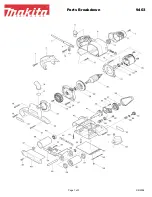
9
EN
Instruction manual
INITIAL OPERATION
Always use the correct supply voltage: the power supply
voltage must match the information quoted on the tool
identification plate.
SWITCHING ON / OFF [F2]
Connect the plug to the power supply.
∙
To start the machine, squeeze the On/Off switch
(4).
∙
To stop the machine, release the On/Off switch (4).
WARNING! The sander is designed
for dry sanding only and under no
circumstances should be used for wet
sanding.
Lock on button
This machine is fitted with a lock on button (5).
∙
When the On/Off switch (4) is depressed, press
lock on button (5) to get continuous operation without
depressing the On/Off switch (4).
CENTRALIZING THE SANDING BELT
[F3]
Check that the sanding belt is running centrally before
using. Centralizing the belt is necessary to stop the belt
running off the rollers.
∙
Turn the machine with the belt facing the operator.
∙
Start the sander and observe how the sanding belt
is running. If the sanding belt is seen to move along
the rollers in either direction, it will require centralizing
before use.
∙
Turn the wing screw for belt adjuster (2) either
clockwise or anti-clockwise to adjust the belt tracking
until the sanding belt is running centrally.
∙
Run the sander for a short time. If the belt is still not
running centrally, use the wing screw for belt adjuster
(2) to adjust the position of the sanding belt.
OPERATING INSTRUCTION
Using the belt sander
∙
Hold the machine with both hands and assume a
balanced posture.
∙
Press the On/Off switch (4) and allow the motor to
reach full speed.
∙
Hold the machine parallel to the workpiece.
∙
Gently bring belt to contact with the workpiece.
WARNING! The sander may initially
snatch forwards. Resist the forwards
motion and allow the sander to move
forwards at a gradual pace.
∙
Do not use excessive, downward pressure, this
may cause the belt to snap.
∙
Keep the sander moving forwards at an even pace.
Failure to do this will result in an uneven finish.
∙
When the operation is finished, lift the sander clear
of the workpiece and release the On/Off switch (4).
∙
Wait until the belt has stopped rotating before
putting the sander down on workbench. Failure to do
this will result in the machine running forwards.
Replacing the sanding belt [F4]
∙
Locate the belt tension lever (10) and pull outwards.
∙
Take care as the lever is under tension and may
spring back to the closed position.
∙
Continue pulling the lever outwards until it locks in
the position shown.
NOTE: the sanding belt has directional!
∙
Sanding belts come in different grades i.e. rough
through smooth.
∙
Select the grade according to the material you are
operating.
∙
Locate the sanding belt on the rollers.
∙
Make sure the sanding belt does not touch the
sides of the casing and that the arrows, printed on the
inside of the sanding belt point in the direction of travel.
∙
Release the tension lever (10).
WARNING! Caution is required as the
lever is under spring tension. Make
sure the lever closes fully. With the
new sanding belt fitted it must be
checked to ensure that it is running
centrally on the rollers.
REPLACING CARBON BRUSHES [F5]
During use, the carbon brushes will wear down and will
be indicated by a possible loss of power and excessive
sparking seen through the ventilation slots. When the
carbon brushes have worn down to approximately 4-5
mm, they will require replacing.
Содержание BS-800G
Страница 4: ...4 2 8 3 4 11 12 1 7 6 5 9 BS 800G ...
Страница 5: ...5 6 11 12 4 2 8 9 10 5 F1 F5 F6 F2 F3 F4 ...
Страница 38: ......
Страница 39: ......










































